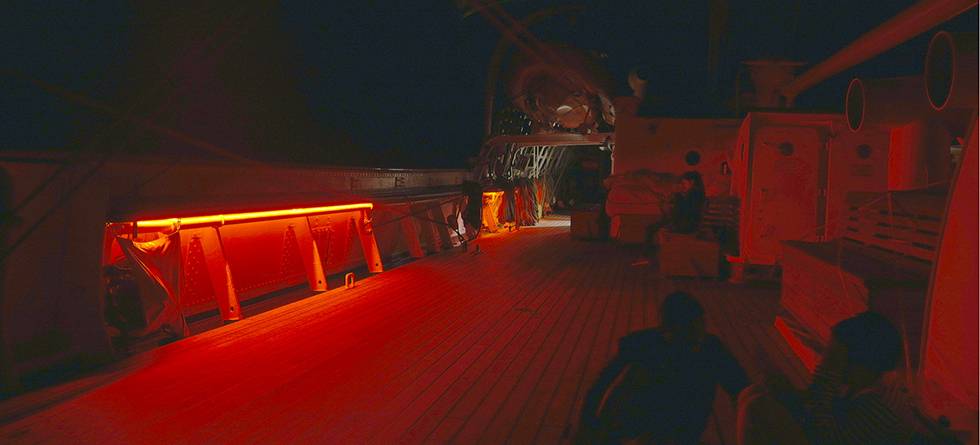The moon is partly hidden behind the clouds, but it is still the main illumination for the halfdeck in the aft of Statsraad Lehmkuhl. There are red night vision-preserving lights in the distance, but they are too far away to be of much help. The day-time buzz on the decks has subsided, and most students, teachers, and crew are fast asleep—all, except us, the night watch.
00:37 a.m. Shouting interrupts the peaceful night scene.
“One-two-pull!”
“One! Two! Pull!”
In the dark, three lines of five people haul away with all their might in order to reposition the long metal bars from which the main sails can be suspended. Each of these so-called yards weighs several tons; to reposition them is hard work even when no sails are set.
After 15 minutes of yelling hauling exertion, the deck falls quiet again. The yards are now in the right position for the sails to be set the next morning.
01:20 am. The clouds have parted and reveal a magnificent starry sky, clearer than I have seen one in a long time. We have a couple of minutes idle time before the next assignment. In the Northern Hemisphere, I would be the one who could point out some constellations. Here, I follow the gestures of a student from the bachelor course SDG200, a seasoned Southern Hemisphere sailor, who points out the Southern Cross. Five stars in a sea of thousands. All others remain unnamed this night.
02:05 a.m. I am back on the halfdeck, this time as far aft as possible on the Statsraad. I am on buoy watch, keeping the lookout for potential men overboard floating by. A lantern illuminates a narrow strip of ocean, an endless succession of waves, eddies from the ship’s propeller, and foaming crests. The lighting is scant, most of the surrounding ocean remains near black. Would I be able to spot an unlucky man overboard in these conditions? I sincerely hope I am never put to the test.
A flash of light in the water.
“What was that!?” shoots through my head, then another flash, before I manage to gather my thoughts from the surprise.
I move closer to the guard rails to see a constant stream of bright spots emerging in the wake of the ship’s propeller.
“Bioluminescence!” I suddenly realise. And sure enough, now there are also some larger patches of ocean that glow blueish for a second or two once they emerge in the ship’s wake. What an infinitely more pleasant surprise compared to the shadow of an unlucky man floating by!
03:30 a.m. “Ding-ding … Ding-ding … Ding-ding … ding.” Three double and a single bell mark that the end of our watch is drawing close. The following watch is woken up and slowly gets ready to take over.
A sharp whistle calls to a final assignment, setting one additional of the many triangular staysails of Statsraad Lehmkuhl.
“Ready in the sheets!”
“Ready in the halyard!”
“Ready in the downhaul!”
After a couple of days at sea such an assignment has become routine, and only a few minutes later one more sail is pulling us forward.
At the end of the watch, I head to my hammock below deck. I am tired but content with the varied and well-spent watch time. There is magic in these hours that is not to be found at other times of the day. While I slowly drift into sleep, I notice that I am actually looking forward to the next night watch.

